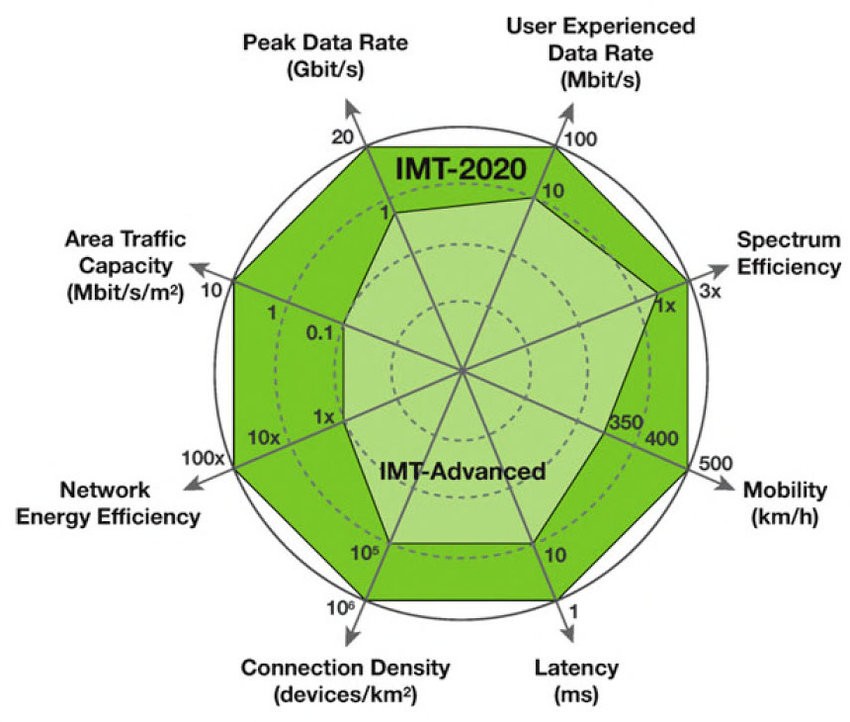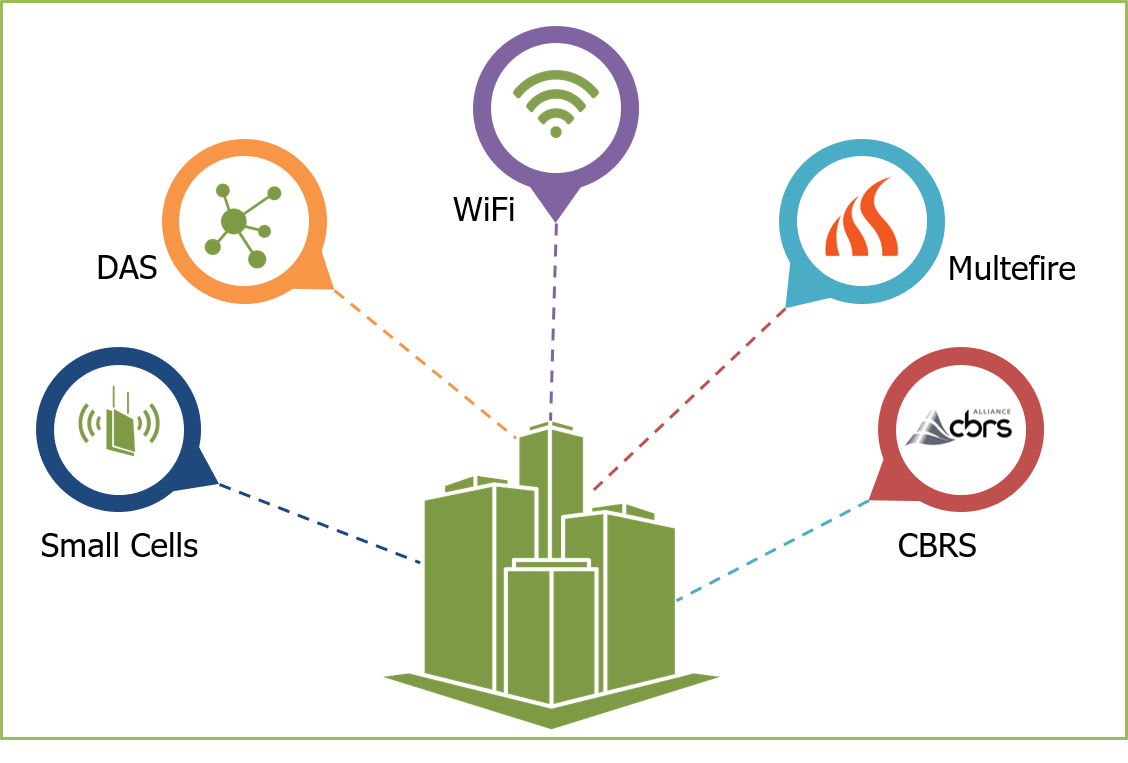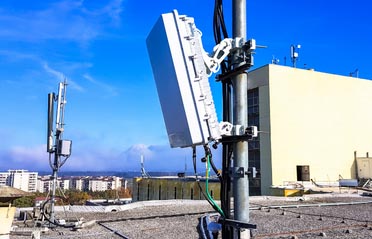5G has an ambitious goal to increase the network capacity by 1000x, reduce network latency for URLL (ultra-reliable and low latency) applications and support ultra-dense deployments to meet IMT-2020 vision as shown in Figure – 1 (see below). Although it meets many of such requirements, in order to comply with all the requirements, it will still have to exploit the opportunities in the unlicensed spectrum, especially Wi-Fi.
According to GSMA’s report, The Mobile Economy 2019, the number of mobile internet users shall grow to 5 billion by the year 2025 and total Internet-of-things connections shall grow to 25.2 billion. Similarly, as per Cisco VNI, by 2022, internet traffic shall grow to 85 GB per user per month where 80% of all the internet traffic shall be video. Thus, as the demand for data continues to grow at an unprecedented rate and as the boundaries between licensed and unlicensed spectrum continues to dissolve, the big question is what role shall 5G and Wi-Fi shall play in the future of communication.

Substitute, Co-exist or Converge
Cellular and Wi-Fi technologies were originally created with very different requirements. The cellular’ s aim was to make telephony mobile whereas Wi-Fi’s aim was to make data links wireless. This led to different network architectures and ownership norms, but the possibility of convergence came when both adopted Internet Protocol (IP) suite.
There was a time when people believed that LTE was conceived by the cellular industry as an answer to the threat posed by Wi-Fi. But Wi-Fi has remained equally important and co-existed well with cellular technologies. Wi-Fi’s importance is also reflected from the fact that by the year 2022, as per the Cisco VNI, Wi-Fi traffic will account for more than 50% of the total IP traffic. Also, the VoWiFi has surpassed VoLTE traffic in 2016 and will surpass VoIP traffic in 2018 in terms of minutes. This is because Wi-Fi serves stationary or nomadic users at a much lower cost than mobile cellular, while mobile remains necessary at speed, for wide area coverage, and for hand-offs during a mobile communications session.
In the past, there was a push for coverage which led to the creation of more and more macro towers. Now we are witnessing the push for densification where antennas are getting close to each other with DAS, small cells and Wi-Fi sitting next to each other; but not slicing the traffic and rather treating them as separate networks. But the future is more about the convergence of technologies such as 802.11ax, MulteFire, CBRS, 5G etc. for more throughput, reduced latency, better coverage and lower cost of ownership.
Convergence
IEEE and 3GPP which used to work independently, started cooperating recently around the integration of WLAN and 4G/5G spectrum which lead to several proposals from both the sides:
- LTE Unlicensed (LTE-U): It was introduced by Qualcomm. It uses the licensed spectrum for control channels whereas data is delivered over unlicensed spectrum.
- License-Assisted-Access (LAA): It implements LBT (Listen-Before-Talk) and the aggregation of bandwidth is controlled by LTE carriers in the licensed spectrum.
- LTE-WLAN Aggregation (LWA): It is based on a dual connectivity framework where data carrier is tunneled through a Wi-Fi access network and control carrier is still anchor by licensed spectrum.
- MulteFire: It is very similar to LAA but it does not require licensed spectrum anchor thereby allowing stand-alone operation of cellular networks in unlicensed spectrum
- ANDSF (Access Network Discovery and Selection Function): It has been developed by 3GPP to assist the end user devices to discover and select non-3GPP networks along with respective policies.
- Hotspot2.0: It’s an initiative from Wi-Fi Alliance Forum (WFA) and is based on IEEE 802.11u specification to enable seamless Wi-Fi network discovery, selection and secure connection at the user device. It allows the use of existing cellular credentials (EAP-AKA, EAP-SIM) to authenticate over the Wi-Fi networks. HSC’s NGH (Next Generation Hotspot) solution is based on this technology.
Wi-Fi is now seen as essential to 5G to the extent that 5G networks are being designed to control them. As per IEEE 5G Workgroup’s roadmap, they are proposing an approach to have 3GPP act as a control channel for all wireless systems available globally. It means, going well beyond today’s licensed assisted access (LAA), cellular would be responsible to coordinate various IEEE 802.11™ Wi-Fi® and other systems to ensure best possible link performance while offering mobility/ roaming, as well as billing.
Figure – 2 (see below) depicts a venue of the future where the existing and upcoming technologies shall converge for seamless connectivity in addition to other benefits such as better user experience, low cost of operations, better monetization opportunities etc.
Future of Wi-Fi
Although there is a push from both the industries for cellular/Wi-Fi convergence, but such offloading poses QoS (Quality of Service) issues due to unmanaged and over-crowded nature of today’s Wi-Fi deployments. So, what is required from the Wi-Fi of the future is a Carrier Grade experience.
Good thing is that a lot of the work done recently, such as Hotspot2.0, allows such cellular-like experience via automatic network discovery, selection and secure connection using existing SIM-based algorithms (EAP-SIM, EAP-AKA). It also facilitates seamless steering of the connections across cellular / Wi-Fi technologies. With Hotspot2.0, even cable operators have an unparalleled opportunity to become big players in Wi-Fi roaming/offload via something called “Homespots”. The idea behind “Homespot” is to share the surplus bandwidth available in each home with roaming subscribers in the local vicinity.
Apart from making the smooth transition from one cell to another, a lot of work is happening in Wi-Fi domain to improve its spectral efficiency and data throughputs. Following are some of the upcoming specifications which reflect such improvements:
- 802.11ax: It is labeled as “Wi-Fi 6” and is meant for high network and spectral efficiency. It shall cater to better coverage, increased speed, faster roaming, load balancing, and higher network density.
- 802.11ad and 802.11ay: They are called “WiGig” as they use 60 GHz spectrum instead of 5 GHz and 2.4 GHz. They shall provide very high bandwidth over short distances.
Therefore, looking at the upcoming improvements and evolution of Wi-Fi technology, one can say that even though Wi-Fi was originally designed for delivering high capacity to stationary indoor users, but it would be able to satisfy the service-level requirements of the cellular networks.
Conclusion
In order to resolve all the future use cases to realize IMT-2020 vision, we shall need all the technologies to work together be it cellular (2G/3G/4G/5G), Wi-Fi or IoT. Such convergence is necessary for scalability, capacity, latency and cost efficiency. Also, the Wi-Fi is focusing on simplifying not just the transition from one cell to another but also working on improving spectral efficiencies and bandwidth over short distances. Now, 3GPP and IEEE both realize that Wi-Fi is essential to 5G and thus they are collaborating to achieve a fair integration.
References

 Product Engineering Services Customized software development services for diverse domains
Product Engineering Services Customized software development services for diverse domains
 Sustenance Engineering Going beyond maintenance to prolong life of mature products
Sustenance Engineering Going beyond maintenance to prolong life of mature products
 Managed Services Achieve scalability, operational efficiency and business continuity
Managed Services Achieve scalability, operational efficiency and business continuity
 Technology Consulting & Architecture Leverage the extensive knowledge of our Domain Experts
Technology Consulting & Architecture Leverage the extensive knowledge of our Domain Experts



























